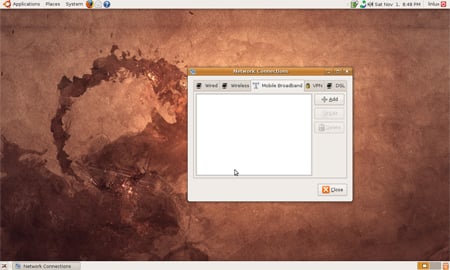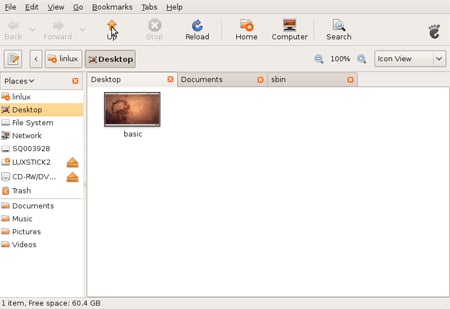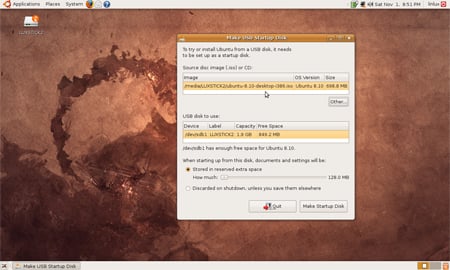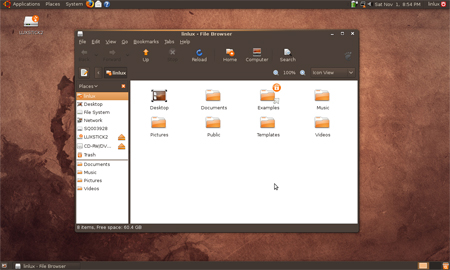Original URL: https://www.theregister.com/2008/11/03/ubuntu_8_dot_one_review/
Ubuntu 8.10 - All Hail new Network Manager
The good kind of UI theft
Posted in Software, 3rd November 2008 18:31 GMT
Review Canonical, the developers behind Ubuntu Linux have release Intrepid Ibex, the successor to last spring's Hardy Heron release. Ibex isn't a long-term support release - which might put off some large organizations - but for Ubuntu desktop fans, version 8.10 makes a worthwhile upgrade.
If you made the leap to Ubuntu 8.10 when it was released last week you may be scratching your head wondering what the fuss is about. The answer is that it might be a few days before you appreciate the small tweaks and overall streamlining in this release. Naturally, there are a slew of new and updated packages - GNOME 2.24, GIMP 2.6, and more - but much of what we love about 8.10 is more subtle.
That said, there are two major changes likely to have an impact on almost all users - the updated NetworkManager app and the new X.org 0.7.
First the positive stuff: The new network manager rocks. Ubuntu has completely revamped the network config panel, and you can now manage wired, wireless, and 3G (GSM/CDMA) connections all in one spot. The 3G features offer a nice wizard that will walk you through tethering to your phone (note that we aren't blessed with compatible 3G phone, so we couldn't test this feature). Presumably the 3G features would work with onboard devices as well, which should be good news for any Ubuntu loving netbook hackers out there.
Another very nice touch - network setup via NetworkManager starts during boot up, which means you don't have to wait for your desktop to load and then wait again while it connects to the web.
The new NetworkManager is a huge win for Ubuntu, and it offers the slickest, simplest network setup tools we've seen in a Linux distro.
Unfortunately we can't say the same for the latest version of X.org. X.org .7 looks nice at first glance. It offers much better support for hot-swappable devices like tablets, keyboards, and mice. As an added bonus, there's no need to mess with the config files - everything should just work.
Normally we'd call that a good thing, but Ubuntu isn't just deprecating the X.org configuration file. It's gone - as in not there, nada, zip, zilch. It'd be nice if everything did just work, but somehow that seems unlikely. Minus the power of hand editing, your config files flies in the face of Linux's fabled customizability. Even if it does just work, what if you want it to just work your way?
It'll be interesting to see how this fully-automated X.org feature goes over with the Linux power users who've been hand-tweaking their files since before most of us knew how to pronounce Ubuntu.
Also worth noting is that Ubuntu 8.10 drops support for some older, proprietary nVidia video drivers. The 71 and 96 series of nVidia drivers (previously available in the nvidia-glx-legacy and nvidia-glx packages) are not compatible with the version of X.Org that ships with Ubuntu 8.10.
If you've got an affected nVidia card, there is a free nVidia driver available instead, but unfortunately that driver does not support 3D acceleration. It would have been nice if Ubuntu had waited for driver parity before dropping the old, but they didn't so if you're affected and you don't want to lose 3-D support, don't upgrade to 8.10.
Bring out the GIMP
Now that we have our major gripes with Intrepid Ibex out the way, let's look at some of the very nice and welcome changes like the kernel upgrade, the latest version of GNOME, GIMP 2.6, and other good stuff.
Although nearly every Ubuntu release features an update to the underlying Linux Kernel, the average home user isn't likely to notice it. But this time around there's a good chance you will. Ubuntu now uses version 2.6.27 of the Linux kernel the new ath9k wireless driver from Atheros. The driver means it's now much easier to get up and running with Ubuntu on a slew of new laptops. The kernel update also introduces improved support for webcam hardware - if you're into that sort of thing.
Ubuntu 8.10 also sees a significant update to GNOME, which is now at version 2.24. You'll find some welcome user interface improvements in the new GNOME, most notably tabbed file browsing. Other improvements in GNOME include the Deskbar search app which can now perform tricks like calculator operations and Google searches. It can even update your Twitter account. Unfortunately, it still isn't all that great of a search tool compared to Vista or OS X's search mechanisms.
If you've been following GNOME development, you'll also be aware that the latest version features a new instant messaging framework by the name of Empathy. However, the Ubuntu developers have opted to retain the old client, Pidgin, until Empathy has time to mature.
There are a few other things missing on the software front, perhaps the most surprising is the new OpenOffice 3.0, which did not make Ubuntu's cutoff date. On the plus side, you do get the latest version of GIMP, which is probably a more important update.
There's a very nice new utility that makes creating a bootable USB version of Ubuntu a snap. All you need to do is select an ISO file and click "Make Startup Disk." Also possibly useful is the new "Cruft Remover," which takes a stab at removing unused packages from your system. Unfortunately packages coming from outside a repository seemed to confuse it. We accidentally deleted VirtualBox and Adobe's AIR platform. While many might consider the latter to indeed be "cruft," heed our warning and exercise some caution with the Cruft Remover.
Also worth mentioning is the new encrypted private directory feature. Once enabled - just install the ecryptfs-utils and ecryptfs-setup-private packages - you'll find a new Private folder in your /home directory. The Private folder is actually an encrypted filestore, which automatically locks and unlocks when you log in and out. Using it, or any files in it, is effectively seamless and much easier than encrypting individual files or folders.
If the new encryption tool gains enough popularity with users, the Ubuntu development team has suggested that future releases may offer an easy way to encrypt your entire /home folder.
The 'dark' theme
Other changes in 8.10 include a refined installer which offers some nice new graphics to show your drive space and setup. There's also a new option to turn on the automatic login features. It doesn't really square with the increased emphasis on security like the file encryption features, but if you like to bypass the login screen on startup, it no longer requires a trip to the login preferences.
At first glance, Ubuntu's theme appears unchanged, but there are in fact some subtle and very Mac OS X-like UI additions. To see Mac OS X's influence, you need look no further than the new eject buttons for plugged in drives and devices or the new live user switching menu which is now in the exact same place as its Mac equivalent. The shutdown/hibernate menu has also been redone to look a bit more professional, though in that case it actually looks less like the Mac version.
Of course, none of this should come as a huge surprise given that Ubuntu founder Mark Shuttleworth has publicly said one of the distro's goals is to mirror the UI design of Mac OS X. Lest you get the idea that Ubuntu is shamelessly stealing from Apple, it's worth pointing out that, while the placement and utility is Apple-esque, the look remains wholly unique to Ubuntu. And that's the good kind of UI theft - take what works and make it your own.
Speaking of looks, Ubuntu has a new and ever-controversial "dark" theme available. Although by default your Ubuntu theme will look pretty much the same as recent releases, if you head into the themes panel, you can easily enable the new dark theme. This happens to fit well with the grunge-inspired desktop image in this version (which, yes, has the faint outline of an Ibex, though to our eyes it resembles a coffee stain more than anything else).
Overall, this is a strong update for Ubuntu, and as with all Ubuntu releases, there's a new version of Kubuntu and other derivatives as well.
The slew of upgraded apps and packages always makes new releases tempting, but for us it was NetworkManager and GNOME's tabbed browser windows that sealed the deal. Of course, if you're affected by the nVidia issues or hate the thought of losing the X.org config files, you might want to hold off on upgrading. Otherwise, grab your copy while it's hot. ®



